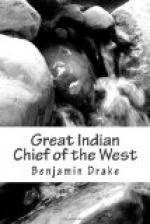any great depth, and a little bark from a tree is made
to answer the purpose of a coffin. The body is
usually carried to the grave by old women, who howl
at intervals, during the ceremony, most piteously.
Before closing the grave, one of the Indians present
at the funeral will wave a stick or war-club, called
“puc-ca waw-gun,” saying in an audible
voice, “I have killed many men in war, and I
give their spirits to my dead friend who lies here,
to serve him as slaves in the other world:”
after which the grave is filled up with earth, and
in a day or two a rude cabin or shed is made over
it of rough boards or bark. If the deceased was
a brave, a post is planted at the head of the grave,
on which, in a rude manner, the number of scalps and
prisoners he has taken in war, is represented by red
paint. Upon the death of an adult, his property
is usually distributed among his relatives, and his
widow returns to her own family or nearest kinfolks.
The widow is the principal mourner for the deceased
and her grief seems to be sincere. Her countenance
becomes dejected—she seldom smiles—clothes
herself in rags, and with disheveled hair and spots
of black paint on her cheeks, wanders about in a pensive
mood, seldom shedding tears, except when alone in
the woods. They generally cease mourning at the
suggestion of some friend, wash, paint themselves
red and put on their best clothes and ornaments.
Some of the Sauks and Foxes entertain the opinion that
the spirit of the deceased hovers about the village
or lodge, for a few days, and then takes its flight
to the land of repose. On its way, they suppose
it passes over an extensive prairie, beyond which the
woods appear like a blue cloud. Between this
woodland and the prairie, there is a deep and rapid
stream of water, across which there is a pole, kept
in continual motion by the force of the current.
This stream, the spirit must cross on the pole, and
if it has belonged to a good person, it will get over
safe and find all its good relations that have gone
before it. In this woodland, game of all kinds
is abundant, and there the spirits of the good live
in everlasting happiness. If on the contrary,
the spirit has belonged to a bad or wicked person
in this world, it will fall off the pole into the
stream, and the current will sweep it down to the
land of evil spirits, where it will forever remain
in poverty and misery. There is nothing very
peculiar in the religious opinions of the Sauks and
Foxes, to distinguish them from the aborigines of this
country, generally. They believe in one Great
and Good Spirit, who controls and governs all things,
and in supernatural agents who are permitted to interfere
in their concerns. They are of opinion that there
is also a bad spirit, subordinate, however, to the
great Manito, who is permitted to annoy and perplex
the Indians, by means of bad medicines, by poisonous
reptiles, and by killing their horses and sinking their
canoes. All their misfortunes are attributed to




